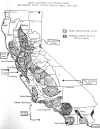Poverty, housing, and the rural slum: policies and the production of inequities, past and present
- PMID: 22813088
- PMCID: PMC3482029
- DOI: 10.2105/AJPH.2011.300864
Poverty, housing, and the rural slum: policies and the production of inequities, past and present
Abstract
We studied historical materials to examine the conditions that gave rise to California's rural slums, the consequences of their emergence, and how interpretations of housing, health, and welfare policies by government officials, and public health officials in particular, produced health inequities for residents of these communities. For more than a century, successive groups of immigrants and domestic migrant laborers have worked on California's farms and faced numerous challenges, among them a lack of safe and affordable housing, poor working conditions, and denial of public services. Although these experiences are not new, nor are they unique to agricultural workers, they illustrate a longer history in which inequities and injustices have been rooted in the exploitation and disposability of labor. Ameliorating or even redressing inequities will require understanding the social determinants of health through ecological approaches that can overcome the historical, social, and political causes of inequity.
Figures
References
-
- S. Richard Street, Beasts of the Field: A Narrative History of California Farm Workers, 1769–1913 (Palo Alto, CA: Stanford University Press, 2004); Carey McWilliams, Factories in the Fields: The Story of Migratory Farm Labor in California (1935; repr., Santa Barbara, CA: Peregrine, 1971); Cletus E. Daniel, Bitter Harvest, a History of California Farmworkers, 1870–1941 (Ithaca, NY: Cornell University Press, 1981)
-
- M. Alexandra Stern, “Sterilized in the Name of Public Health: Race, Immigration, and Reproductive Control in Modern California,” American Journal of Public Health 95, no. 7 (2005): 1128–38; Nayan Shah, Contagious Divides: Epidemics and Race in San Francisco’s Chinatown, American Crossroads, 7th ed. (Berkeley, CA: University of California Press, 2001); Natalia Molina, Contested Bodies and Cultures: The Politics of Public Health and Race Within Mexican, Japanese and Chinese Communities in Los Angeles, 1879–1939 (Ann Arbor: University of Michigan, 2001); Alan M. Kraut, Silent Travelers: Germs, Genes, and the “Immigrant Menace” (Baltimore, MD: Johns Hopkins University Press, 1995); Amy L. Fairchild, Science at the Borders: Immigrant Medical Inspection and the Shaping of the Modern Industrial Labor Force (Baltimore, MD: Johns Hopkins University Press, 2003); Amy L. Fairchild, “Policies of Inclusion: Immigrants, Disease, Dependency, and American Immigration Policy at the Dawn and Dusk of the 20th Century,” American Journal of Public Health 94, no. 4(2004): 528–39; Judith W. Leavitt, Typhoid Mary: Captive to the Public’s Health (Boston, MA: Beacon Press, 1996); Natalia Molina, Fit to Be Citizens?: Public Health and Race in Los Angeles, 1879–1939, American Crossroads (Berkeley, CA: University of California Press, 2006); H. Balcazar, “Tuberculosis in Mexicans: Learning from the Past to Provide Lessons for the Present,” American Journal of Public Health 101, no. 7 (2011): 1211–12; Emily K. Abel, “Only the Best Class of Immigration: Public Health Policy Toward Mexicans and Filipinos in Los Angeles, 1910–1940,” American Journal of Public Health 94, no. 6 (2004): 932–9; Natalia Molina, “Borders, Laborers, and Racialized Medicalization Mexican Immigration and US Public Health Practices in the 20th Century,” American Journal of Public Health 101, no. 6 (2011): 1024–31. - PMC - PubMed
-
- California’s 1937 Welfare and Institutions Code, (superseded in 1965 by § 17000), was a great improvement from the 1855 Pauper Acts and formalized the obligation of local counties to provide access to health care for medically indigent populations. See California Welfare and Institutions Code, § 2556 (1937), which discussed “What Constitutes County Residence.” Welfare and institutions code annotated of the state of California: adopted May 25, 1937, with amendments up to and including those of the 1961 regular session of the Legislature: San Francisco: Bancroft–Whitney Company; 1962. For a historical overview of California’s relief programs, see also Kerry R. Bensinger, “From Public Charity to Social Justice: The Role of the Court in California’s General Relief Program,” Loyola of Los Angeles Law Review 21(1987–1988): 497–541.
-
- H Lefebvre, The Urban Revolution (Minneapolis: University of Minnesota, 2003); William Cronon, Nature’s Metropolis: Chicago and the Great West, 1st ed. (New York: W. W. Norton, 1991). This rural focus is not intended to dismiss Lefebvre’s discussion of the urban fabric as absorbing the rural into its industrial production, nor does it dismiss Cronon’s insightful claims that urban and rural landscapes have cocreated one another. Rather, it reasserts the importance of agricultural workers in a working-class history of the United States and creates an opportunity to examine the institutionalization of inequities in California’s rural landscape while also giving attention to the process of labor subordination that takes place in those rural spaces.
-
- M. McDonough, Report to the Governor’s Council, California Department of Industrial Relations, Los Angeles (Sacramento: California State Printing Office, 1951), 12.
MeSH terms
LinkOut - more resources
Full Text Sources
Medical
Miscellaneous


